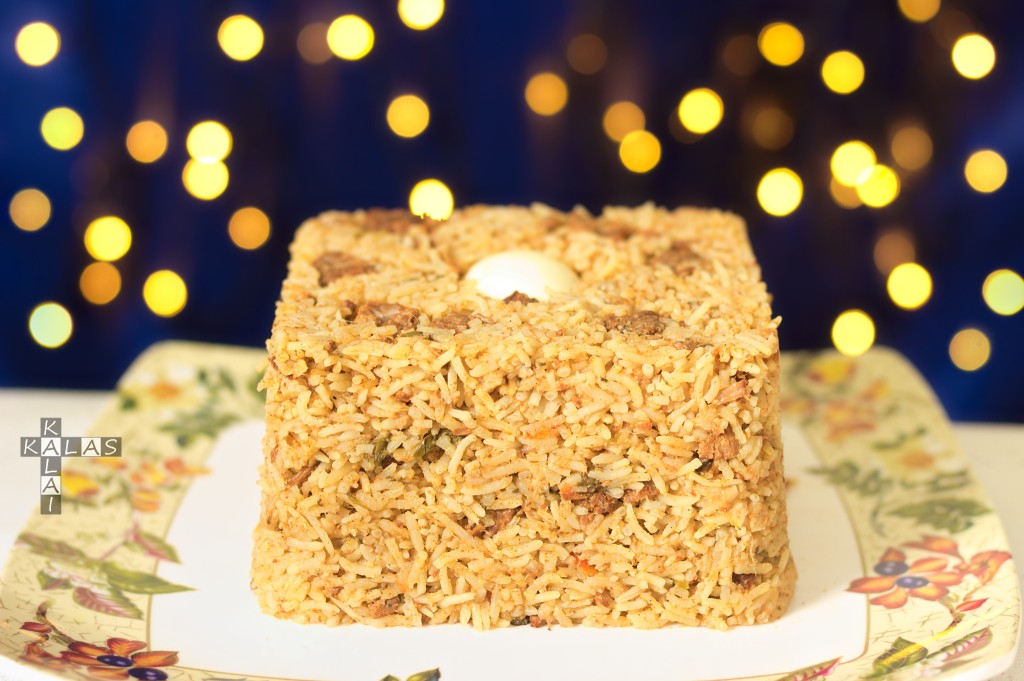India banned cow slaughter in 1977, so my husband’s friend used to refer to beef dishes as bull dishes as bull slaughter was (and is) allowed. My family loves the rich flavour of beef and I have been making this biriyani for 4 decades, especially for the Christmas feast. I created a beef biriyani recipe as mutton prices had soared and good mutton was hard to get. I have refined this recipe over the decades and it is now a sumptuous, satisfying, and irresistible treat. I serve it with my Sweet and Sour Brinjal Masala and Thayir Pachadi (Yoghurt and Onion Salad). I have now begun serving this biriyani with a boiled egg as well, as all the restaurants serve biriyani this way and it makes this biriyani extra festive.

Nutritive Value
The main ingredients in a biriyani are rice and meat. While rice provides carbohydrates, the meat (depending on the type you use) provides 21-24g of protein per 100g. The mint and coriander leaves and tomatoes add sufficient anti-oxidants to protect the system from the fat in the meat. The vegetable oil used provides unsaturated fatty acids and thus the risk of anticipated hyperlipidemia is quite low 🙂 The addition of the egg also gives a boost to the already high quality of protein in this biriyani. It is a very high energy and high protein dish though no one cares about all that as it is biriyani 😀
Ingredients
- 1 kg Beef cubes
- 4 C Basmati Rice
- 1 C Ginger-Garlic Paste
- 2 tsp Chilli powder
- ½ tsp Cinnamon Powder
- ½ tsp Clove Powder
- ½ tsp Turmeric powder
- ½ C Curds (Unsweetened Yoghurt)
- 4 large Onions, sliced
- 4 large Tomatoes, chopped
- 1 C Coriander Leaves, chopped
- 1 C Mint Leaves, chopped
- 10 Green Chillies
- ½ C Ground Coconut
- 1 Lime, juice extracted
- 3 sticks (4 cm each) Cinnamon
- 6 Cloves
- 6 Cardamom
- 5-6 tsp Salt
- ¾ C flavourless Vegetable Oil
- 8 C Water (approximately)
- Boiled Egg (optional), one for each plate
Method
- Marinate the beef cubes with turmeric and chilli powder, half cup of ginger-garlic paste and curds for 30 minutes.
- Wash the basmati rice and drain in a colander.
- Heat the oil in a medium pressure cooker. Add the whole spices (cinnamon, cloves, cardamom). As soon as the cloves begin to swell, add the onion, and fry till translucent.
- Add the coriander and mint leaves, and stir till a lovely fragrance arises.
- Add the chopped tomatoes and the green chillies and stir. Close the pressure cooker and cook for a few minutes without adding weight.
- Open the pressure cooker, add the rest of the ginger-garlic paste and the cinnamon and clove powders. Stir till an appetizing aroma arises.
- Add the beef cubes, and fry till the colour of the pieces changes. Add salt.
- Add the marinade and two cups of the water. Pressure cook for 30 minutes.
- After the pressure cooker is cooled, transfer the meat pieces to a large heavy-based pan.
- Measure the gravy left in the cooker. Add to the pan.
- Add the ground coconut and lime juice.
- If the gravy is two cups add six cups of water. Adjust the amount of water according to the amount of gravy you have to get totally eight cups of fluid.
- Bring to boil. Add the basmati rice and stir. Bring to boil again.
- Lower heat and close the pan. Cook till all the water is absorbed. Stir only once midway to distribute the masala evenly.
- Remove from heat and serve hot, with sweet and sour brinjal masala and thayir pachadi and boiled egg.
Notes
- If you wish to tenderise the meat, pound the beef before marinating.
- I use two cups of water for one cup of basmati rice (Double Deer). This amount may vary from brand to brand.
- I use Kashmiri chilli powder for its mild flavour and glorious colour.
- I use sunflower oil supplemented with rice bran oil for its cholesterol-lowering properties.
